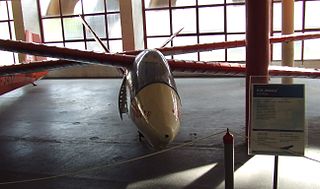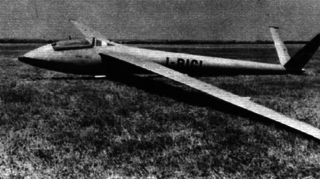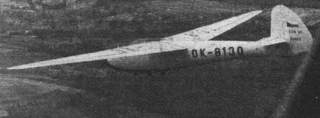Related Research Articles
The Akaflieg Darmstadt D-34 sailplanes were a series of experimental single seat sailplanes, designed at the University of Darmstadt in the 1950s and early 1960s to explore the structural and aerodynamic advantages of the then emerging plastics and composite materials.

The Rubik R-25 Mokány, in English: Plucky person and sometimes known as the R-25 Standard (class), is a Hungarian single seat Standard Class glider of all-metal construction, first flown in 1960. It was one of a series of similar aircraft designed by Ernő Rubik. Only one was built.
The Kirigamine Mita is a training glider, seating two in tandem, designed in Japan in the early 1960s. A modified version, first flown in 1966, was produced in modest numbers.
The VTC Delfin is a competition single seat Standard class glider designed and built in Yugoslavia in the 1960s. It had some success in national competitions and went into small scale production.

The Ciani EC 38/56 Urendo, or SSVV EC 38/56 Urendo is an Italian tandem-seat training glider from the 1950s. Four were built, one winning the Italian National Championships in 1959. Another, restored, still flies.
The CVT1 Zigilo was a single-seat, 12-metre-span (39 ft) Italian training glider designed and built in Italy in the 1950s. Only one was completed.

The Bruni 3V-1 Eolo was a single seat Italian competition glider, first flown in 1955. It took part World Gliding Championships of 1956 but retired early after sustaining damage.
The IIL IS-5 was a single seat, high performance sailplane designed by Iosif Șilimon and built in Romania in 1960.
The IIL IS-7 was a two-seat, sailplane designed by Iosif Șilimon and built in Romania in the late 1950s. Only one prototype was built.
The IIL IS-8 was a two-seat sailplane designed by Iosif Șilimon and built in Romania in 1960. They served with Romanian gliding clubs.
The IIL IS-10 was a high-performance, single-seat glider, designed and built in Romania in the early 1960s. It was the first Romanian aircraft to use laminar flow airfoils.
The IIL IS-11 was an aerobatic, single seat glider, designed and built in Romania in 1959. It was built in small numbers.
The IIL IS-12 was a two-seat glider, designed and built in Romania in 1960. It had a wooden wing but a metal fuselage and was constructed in parallel with the all-wood IS-13 for comparative tests. It was later followed by the IS-13a, a version with an all-metal wing.

The ICA IAR-35 is a Romanian glider designed and built in the 1980s primarily for aerobatics, though capable of general purpose use. Several production prototypes were constructed.
The Schleicher K 10 is a Standard class competition glider, designed by Rudolf Kaiser and built in Germany in 1963. Only a few were produced.
The Merville SM.31 is a French high performance glider with a laminar flow wing, first flown in 1960. Only one was built.

The Zlín Šohaj series of club gliders began as a post World War II development of the DFS Olympia Meise. A large number were built in the 1940s and '50s.
The Civil Aviation Department BS-1 Bharani was a tandem seat trainer glider designed and built in India in the early 1960s.
The Civil Aviation Department Ashvini was the first two-seat glider designed and built in India. It was produced in small numbers in the early 1960s.
The Jancsó-Szokolay M22 was a Hungarian single-seat sailplane first flown in 1937. Twenty were built and the type set several national records. Some remained in service up to about 1953.
References
- 1 2 3 Taylor, John W R (1974). Jane's All the World's Aircraft 1974-75. London: Jane's Yearbooks. p. 583. ISBN 0 354 00502 2.
- 1 2 3 4 Taylor, John W R (1964). Jane's All the World's Aircraft 1964-65. London: Sampson Low, Marston & Co. Ltd. p. 367.
- 1 2 Taylor, John W R (1976). Jane's All the World's Aircraft 1976-77. London: Jane's Yearbooks. pp. 572–3. ISBN 0 354 00538 3.